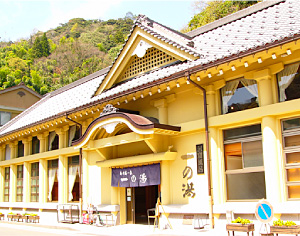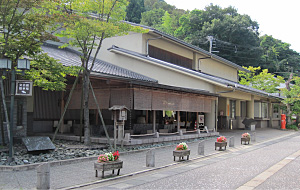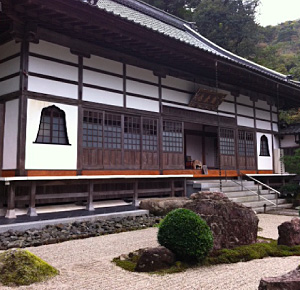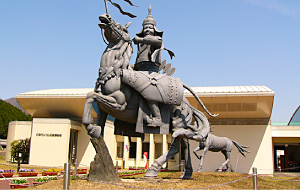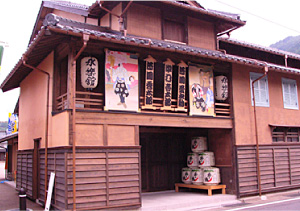Sightseeing

- Kinosaki 7 open-air public bath houses
-
This is what makes this town famous. Legend has it that storks would bathe in the hot spring marshes of Kinosaki to heal their wounds. Eventually bath houses were built over these sites to take advantage of the healing waters. Now there are seven traditional Japanese public bath houses with open-air baths located throughout Kinosaki Onsen. Natural underground spring water is pumped into the baths on a regular basis. The hotspring water is said to have therapeutic and healing qualities. Take your time relaxing in these soothing bath houses. If it is your first time be sure to follow the bath houses’ rules and manners. Some basics are: Shower and rinse off well before entering the baths, do not put your towel in the bath water, tie long hair up and out of the water, no clothes or swimsuits allowed.
Access
Located along the main streets of Kinosaki Onsen. In order from closes to the station is Sato no Yu, Jizo Yu, Yanagi Yu, Ichi no Yu, Gosho no Yu, Mandara Yu, and Kono Yu.
- Kinosaki Onsen Temple
-
Located at the western edge of town, this temple is dedicated to a Buddhist monk who is said to have prayed for 1000 days to bring forth the spring waters to Kinosaki. In the old days, when the town was first established as an onsen resort, visitors were required to pay a visit to the temple before being admitted to any of the baths in town. The main temple is located midway up the mountain. There is an additional temple dedicated to Yakushi Buddha located at the foot of the mountain.
Access
Located on the western end of town, near the Kono Yu public bath house. About a 15-25 minute walk from Kinosaki Onsen station.
- Cultural Center and Museum
-
This is a small art and literature museum located along Bunkeikan St. (just one street behind the main street). This museum was constructed in the style of a traditional Japanese house. Inside visitors can view works of poets, authors, artists, and other works by historical Japanese figures. All of the works displayed were influenced and reflect on the town of Kinosaki. Near the entrance of the building visitors can also try to make a simple craft using a traditional craft called mugiwara-zaiku, traditional straw work, original to Kinosaki.
Access
Near the center of the town, one block back from the main street that runs along the Otani River.
- Straw Work Museum
-
Kinosaki Straw Work Museum displays pieces of art called mugiwara-zaiku. This is a traditional handicraft unique to this area. The technique uses brightly dyed strips of straw. The straw is then carefully cut and laid out in intricate patterns. These are then used to decorate various items from post cards to traditional Japanese wooden boxes. The museum displays how the craft has been refined to its current level of mastery over a period of about 300 years. Visitors can also learn how to create their own mugiwara-zaiku at the Bungeikan (Cultural Center and Museum).
Access
Along the Otani River in the back next to the parking lot closest to Ichi no Yu public bath house.
- Zazen
-
Seated Zen Meditation. Visitors to the temple are welcome to join the monks in meditation. After the meditation you can stay for green tea and snacks. The monk will teach you the proper posture, from how to fold your legs, how far to close your eyes and how to hold your hands.
Access
Located on the western end of town near the fire department. The temple is located just south down the road from the fire department.
- Mongolian Folk Museum
-
Japan Mongolian Folk Museum is located in the rural part of Kyoto prefecture. Here you can learn about the culture and history of Mongolia. Within the facilities are a traditional Mongolian hut and clothing that you may try on.
Access
From Kinosaki Onsen Station take the San-in Line to Toyooka station. Take the Zentan Bus to Izushi. At Izushi (出石)change buses to the Zentan Bus bound for Okufuji (奥藤) and get off at Hakubutsukan-mae (博物館前)
- Izushi Eirakukan
-
Izushi Eirakukan is an old fashioned and classic example of a traditional Japanese kabuki theater. Complete with a revolving stage for grand scene changes and hidden drop doors for the quick and “magical” appearances of the characters. The theater is till used today for kabuki performances. Visitors also have the option of taking a tour behind the scenes when there is no production running at the time.
Access
From Kinosaki Onsen Station take the San-in Line to Toyooka Station and transfer to the Zentan bus for Izushi. Get off at the Izushi Castle, it is about a 10 minute walk to the theater.















